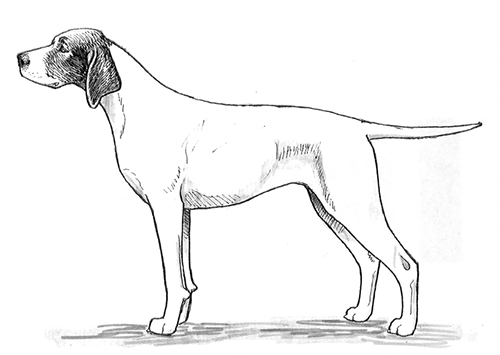Braque Saint Germain
Gun Dog Group
The goals and purposes of this breed standard include: to furnish guidelines for breeders who wish to maintain the quality of their breed and to improve it; to advance this breed to a state of similarity throughout the world; and to act as a guide for judges.
Breeders and judges have the responsibility to avoid any conditions or exaggerations that are detrimental to the health, welfare, essence and soundness of this breed, and must take the responsibility to see that these are not perpetuated.
Any departure from the following should be considered a fault, and the seriousness with which the fault should be regarded should be in exact proportion to its degree and its effect upon the health and welfare of the dog and on the dog’s ability to perform its traditional work.
History
A French pointing breed that was created around 1830 by crossing an English Pointer with a Continental Pointer. The breed was in great vogue until the beginning of the 20th Century; being the most shown pointing breed in the first French dog shows.
The Braque Saint Germain was recognized by the United Kennel Club in 2006.
General Appearance
A medium sized fawn and white pointing breed with relatively heavy bone and strong musculature.
Characteristics
Sociable and easy to train, the Braque Saint Germain is an excellent hunter, with a soft mouth.
Head
SKULL
The skull is slightly rounded, with a prominent occipital protuberance. The stop is not too pronounced.
MUZZLE
The muzzle is the same length as the skull. The bridge of the nose is straight or very slightly convex. The lips are fine, and cover the lower jaw. There is no black on the lips or the palate.
TEETH
The Braque Saint Germain has a complete set of strong, white teeth meeting in a scissors bite.
Disqualifications: Overshot or undershot bite.
NOSE
Broad, with well opened nostrils. Pink in color.
Disqualification: Black nose.
EYES
Relatively large and well opened, set well into the orbits. Golden yellow in color, with a mild expression.
Disqualifications: Brown or black eyes. Black pigment.
EARS
Set on a level with the eye, and not too long. Rounded at the ends, and slightly detached from the head.
Neck
Well muscled, relatively long, and slightly arched. A slight dewlap is tolerated.
Forequarters
The shoulder blades are long, oblique and muscular. The upper arm is slightly sloping.
FORELEGS
Strong, muscular and vertical, with good bone. Pasterns are short and slightly sloping.
Body
The chest is long, deep and broad, with a slightly protruding prosternum. The ribs are long and well sprung. The back is horizontal, and the loin is short, broad and sturdy. The croup is slightly sloping. There is a slight tuck up.
Hindquarters
The limbs are well poised when seen from behind.
HIND LEGS
The thighs are long and well muscled. The rear pasterns are short, vertical and dry.
Feet
Long, with tight toes and firm pads. The nails are light.
Disqualification: Black nails.
Tail
Set relatively low, strong at the base, and tapering to a point. It does not reach further than to the point of the hock. In action, it is carried horizontally.
Coat
Short, and not too fine.
Color
Dull white with orange (fawn) markings. Some ticking is tolerated but not sought after. The ear is fawn, some white is tolerated.
Disqualification: Black in coat.
Height
Height for males is 22 inches to 24.5 inches. For females, it is 21 inches to 23.5 inches.
Gait
The Saint Germain covers ground well, regardless of the gait it is using. The head is carried above the topline, never lower.
Eliminating Faults
(An Eliminating Fault is a Fault serious enough that it eliminates the dog from obtaining any awards in a conformation event.)
Height one inch or more outside the limits of the standard.
Disqualifications
(A dog with a Disqualification must not be considered for placement in a conformation event, and must be reported to UKC.)
Unilateral or bilateral cryptorchid.
Viciousness or extreme shyness.
Albinism.
Overshot or undershot bite.
Brown or black eyes.
Black nose.
Black pigment.
Black in coat.
Black nails.

Looking for a Dog?
Find a dog that will fit your family.
Note: The breeders on this list are not endorsed by UKC.
Revised July 1, 2009
©Copyright 2006, United Kennel Club
